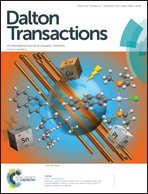Combination effect of ionic liquid components on the structure and properties in 1,4-benzenedicarboxylate based zinc metal–organic frameworks†
Abstract
Two types of 2D [RMI]2[Zn3(BDC)3X2] (Type A) and 3D [Zn(BDC)(H2O)] (Type B) (H2BDC = 1,4-benzenedicarboxylate acid) compounds were synthesized with three kinds of 1-alkyl-3-methyl imidazolium halide ([RMI]X) ionic liquids. Type A is the primary structure model showing a (3,6) network. Type B can be obtained from [BMI]Cl, [AMI]Cl and [AMI]Br media, showing a 4,4-connected {42·84} network. The structure, TG, and fluorescence analyses demonstrate the combination effect of the RMI+ templating effect and X− controlling the structure types. The boundary between Types A and B is from [PMI]Cl, via [BMI]Br, to [AMI]I as the reaction media. The decomposition temperatures of the compounds in Type A decrease with increased RMI+, while X− anions exert the influence that compounds containing Br− supply the highest thermal stability. Similarly, with increased RMI+, or X = I−, the compounds show red shifts compared to the emissions of the ligand.


 Please wait while we load your content...
Please wait while we load your content...